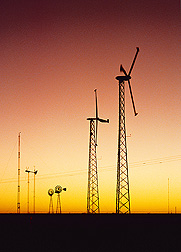Power Needs and Wind Power as Different as Day and Night
|
|
Brian Vick found that, in parts of Texas and California, an almost perfect match between wind-power production and peak energy demands can be obtained by combining wind power with solar power, and by proper storage of excess energy when power supply exceeds demand.
Vick is an agricultural engineer at the Agricultural Research Service’s Renewable Energy and Manure Management Research Unit in Bushland, Texas.
Vick found that in both the Texas Panhandle and California, there is almost an exact mismatch between wind-power production and peak energy demands over a 24-hour period. In these locations, at the tops of modern wind turbines, winds are lowest at midday, when power demands are greatest. In Texas, there is a seasonal mismatch as well: The winds are weakest in the summer, when power demands peak. But adding solar power helps because the sun’s rays are most intense at midday and in summer months.
When wind or sun power generated exceeds demand, it’s important to capture the energy and store it. The most efficient storage system is one being used in solar thermal power plants, where the sun’s energy is used to heat water or other fluids. The fluids are kept hot long after the sun goes down and can be used later to produce steam to generate electricity. The excess electricity generated by wind in the late night and early morning hours could be pumped into the grid and stored to supply power when wind and solar power are insufficient.
Vick and colleagues at Bushland design and test wind/solar/biodiesel hybrid systems running on an experimental electric grid. They also operate modern turbines for wind-farm research for the U.S. Department of Energy.
Vick expects that a better blending of solar and wind power will increase the use of renewable energy for California, Texas, and the rest of the nation. Texas is the top state for wind-generated electricity production, with Iowa second and California third. California is the leader in solar-generated electricity production.—By Don Comis, Agricultural Research Service Information Staff.
Brian D. Vick is in the USDA-ARS Renewable Energy and Manure Management Research Unit, 2300 Experiment Station Rd., Bushland, TX 79012-0010; (806) 356-5752.
"Power Needs and Wind Power as Different as Day and Night" was published in the August 2010 issue of Agricultural Research magazine.







